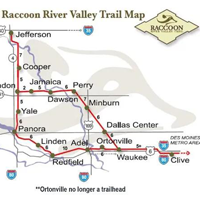History
History buffs are sure to appreciate these local gems!
The City of Adel, Iowa: Population 3,435
Founded as the county seat, Adel Iowa was originally called Penoach and is the oldest community in Dallas County. Native American artifacts found in the area provide evidence of earlier residents including Sac and Fox Tribe of the Mississippi in whose language Penoach means “far away”.
Adel Historical Museum: 1129 Main Street
This two-story brick building, built in 1857, was once used as the second Adel schoolhouse. The museum contains 8 rooms filled with artifacts from the history of Adel. Volunteers throughout the community help with opening and manning the museum on Saturdays from May to September. Other times the museum may be toured by reservation by calling 993-1032. The two main events of the Adel Historical Museum are the Holiday Home Tour in December and the Corn Festival in August. Learn more about the history of Adel with museum Curator Jan Price!
Nile Kinnick’s Boyhood Home: 219 North Twelfth Street
This private residence was home to the Adel hero and Iowa legend, Nile Kinnick. Nile Kinnick was born in Adel on July 9, 1918 to Nile Sr. and Frances Clarke Kinnick. He was a standout athlete at Adel High School before winning the Heisman Trophy at the University of Iowa, having scored 107 of the 130 points scored by the Hawkeyes that year. Nile Kinnick was a Navy pilot during World War II and died on June 2, 1943 when his plane went down. Highway 169 going north & south through Adel is named Nile Kinnick Drive in his honor.
The Dallas County Courthouse: 801 Court Street
An outstanding example of French Chateau architecture, the (fourth) Dallas County Courthouse was built in 1902 and is now on the National Register of Historic Places. The interior of the courthouse has undergone a complete restoration and is the cornerstone of Adel’s Historic District. The Court House remains in commission and tours may be scheduled through the Adel Partners Chamber of Commerce by calling (515) 993-5472. Read an interview with Bill Clark about the Court House here!
Adel’s Historic District
Centered around the Dallas County Courthouse, Adel’s beautiful Historic District comprises the downtown square and brick streets. Recently designated to the National Register of Historic Places, Adel is the only location to have registered both the buildings and roads as historical landmarks. During the summer of 2010, the City of Adel renovated the streets and is one of the only street projects in Iowa to reuse the authentic bricks.
The Chicago-Milwaukee-St. Paul Depot: 218 South 9th Street
This early 1900s train depot was built to serve the railroad running through Adel until 1952 when the last passenger train ceased service. The Depot was home to a restaurant before the law firm of Hefner and Bergkamp P.C. remodeled the historic train stop. interior decor includes a collection of historic photographs of Adel and original wood. The railbed is currently the Raccoon River Valley Trail which now boasts 125,000 users a year!
Raccoon Valley State Bank Community House: corner of Eleventh and Main Street
Constructed in 1862, the Methodist Episcopal Church was the first church built in Adel. It was used by the congregation for 25 years and later became a private residence. In 1995 the building was renovated by the Raccoon Valley State Bank for use by community groups. Interior decor includes a collection of historic photographs of Adel which can be viewed by appointment. The building is frequently reserved for social gatherings of all types. For tours and reservations, please call (515) 993-4581. George W. Clarke House: 207 North 15th Street This private residence was the home of George W. Clarke, Iowa Governor from 1913-1917, both before and after his term in office. He practiced law in Adel and maintained his office in the Adel State Bank where he nearly lost his life in the famous 1895 robbery of the Adel State Bank.
Adel State Bank: 107 North 9th Street
This building was the scene of the March 1895 famous bank robbery. One robber was killed and six Adel men were wounded. George W. Clarke practiced law on the second floor. During the robbery, one of the hold-up men pulled the trigger on Clarke at pointblank range but the gun misfired and the future governor was saved.






